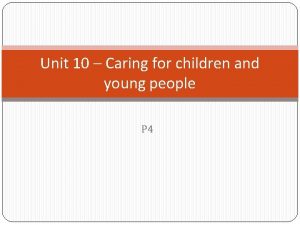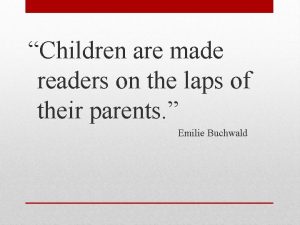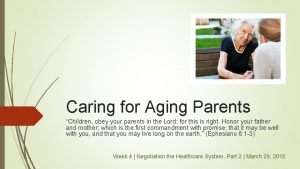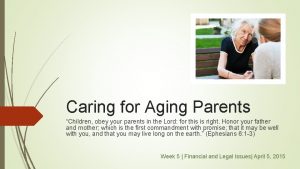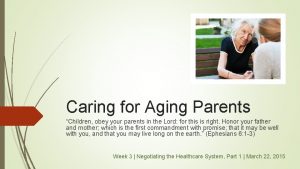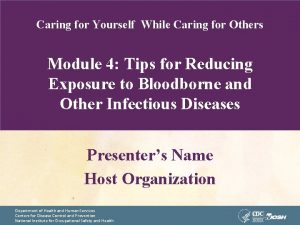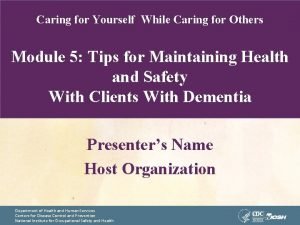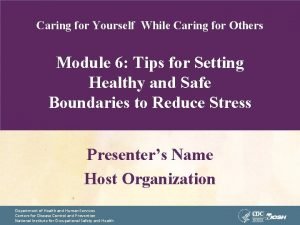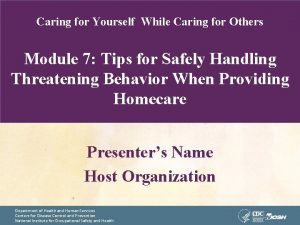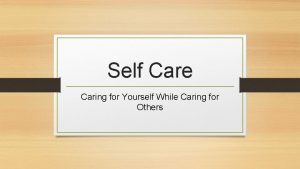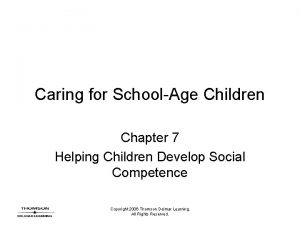Sandwiched Caring for Parents while Caring for Children





























- Slides: 29

Sandwiched: Caring for Parents while Caring for Children (and sometimes Grandparents and Grandchildren) “Sandwich Generation” gets stuck in the middle

You’re rushing to drop the kids at school, fumbling with coats and lunchboxes, when you get the call. Mom’s had a fall, and she’s in the E. R. Your dad is panicked and asking you to come home, now. But “home” is 1, 200 miles away, and the last-minute flight, plus the home health aide you’ll have to hire, will set you back $1, 500 at least. And, oh yeah, you’re scheduled to give a major presentation to your biggest client this afternoon. You’re worried about your mom, your dad, your kids, your boss, and how in the world you’re going to pay for it all. — CNNmoney. com

42 million American women are “sandwiched” by the caregiving and financial needs of their own children and their aging relatives, at a time when women are having children later and their parents are living longer. The squeeze is expected to intensify, as one in five Americans will be 65 or older within the next two decades.

A new survey conducted by Harris Interactive found that more than half (53 percent) of caregivers feel forced to choose between caring for their children or parents at least once a week. Twenty percent feel that way every day. The bottom line: Caregivers need help. How can they handle the stress? Where do they go for help? Before answering those questions, let’s get to the meat of the typical sandwich situation:

The typical American Sandwich Generation Caregiver is… ● ● In her mid-forties Married Employed Caring for her family and an elderly parent (usually her mother) ● Reluctant to ask for help or doesn’t know where to turn There also increasingly more men that find themselves in a caregiving role and even squeezed in between the generations.

Terms coined by Carol Abaya of The. Sandwich. Generation. com u Traditional Sandwich n those sandwiched between aging parents who need care/help and their own children u Club Sandwich n those in their 50 s or 60 s, sandwiched between aging parents, adult children and grandchildren OR those in their 30 s and 40 s, with young children, aging parents, and grandparents u Open Faced Sandwich: n anyone else involved in elder care

Sandwich Generation Concerns Social workers are reporting that the majority of the sandwich generation are not prepared for many aspects of their aging relatives’ care, including: ● Being the least prepared to deal with the cost of their aging relatives’ care ● Underestimating the financial, emotional, and physical toll of providing care for aging relatives ● Delaying getting help because they feel they should be able to shoulder caregiving responsibilities on their own

Sandwich Generation Concerns Social workers are also reporting that they ease caregivers’ burdens by providing care management or care coordination for aging relatives. This includes: ● Making referrals to health and social services ● Arranging transportation and food delivery ● Advising on financial management and benefits ● Acting as a liaison for long-distance care

By accepting help from outside sources, a caregiver “can concentrate on being a daughter, a mother, and a spouse. Understand that for however long it takes, this is your life, not something you can hurry up and get through. Come to grips with the reality that it affects the entire family, whether you want it to or not. And be mindful. Make a plan that accounts for the dignity of the senior, the sanctity of the marriage, the demands of being a parent, and the sanity of the caregiver. And when that plan stops working, make another plan. ’’ — Jeannie Keenan, Case Manager

Sandwich generation caregivers often feel stress over: u How do I split my time between my children/family and my elder loved one? u How much of my time is too much time in each caregiving role? u How do I find the time for my marriage? u How do I find the time for myself? u How do I keep the generational peace between my kids and my elder loved one?

Sandwich generation caregivers often feel stress over: u How do I find the resources I need for myself and my loved one? u How do I combat my feelings of isolation? u Guilt, guilt, and more guilt for not having enough time to accomplish all that I “should” be doing.

To counter some of these stress points, try these caregiver tips:

Hold a Family Meeting u Discuss the many different caregiving tasks that need to be accomplished each day or week. u Set a task list for family members to complete each day/week. u Set mutual expectations of how the many tasks of caregiving will be accomplished. Caregiving is often a one-person show, but it does not need to be if the caregiver has family support. The family meeting also allows for family members to participate and share in the valuable gift of caregiving which can be very rewarding.

Communicate u Encourage children and elders to communicate with one another. u During the family meeting, make sure that all family members have a chance to talk about their thoughts and feelings.

Get the Facts and Avoid Surprises u Caregivers should talk to their parents about how they’re doing financially and what plans they’ve made if they become ill or incapacitated. u While they’re at it, they should also get a grip on their own financial needs, too. Run the numbers to assess how much money is needed for retirement and sending children to college.

Get the Facts and Avoid Surprises u As much as a caregiver wants to support his/her parents, it’s imperative that he/she put saving for retirement, and perhaps college, first. u “That should be the priority for most people, ” says Tim Casserly, an elder-care lawyer in Albany, N. Y. “After all, you won’t find the same government programs to help you raise your kids or fund your retirement that you’ll find to help you support your parents. ”

Ask for Assistance n Call resources such as the local Area Agency on Aging, a hospital social worker, a physician or a church. n Call for in-home help from a local agency. n Never be afraid to ask for assistance. n The Internet can also be a wonderful resource-finding tool. Try www. compassionatejourney. weebly. com.

Care for the Caregiver Too often caregivers get run down and even sick because they have not taken time for themselves. Taking a break is not an act of selfishness. It is actually an act of great giving. Caregivers should: ● Spend time—even ten minutes a day—“checking-in. ” This should be protected time to read, listen to music, exercise, etc. ● Laugh at the funny things in life.

Care for the Caregivers should: ● Take time to be “in” their marriage. ● Listen to their body. If the body is saying slow down, or that something is not right, medical advice should be sought. Too often we do not listen to our bodies no matter how loudly they may be talking to us.

Get the Power in Case an Emergency Arises Caregivers will need legal authority to act swiftly on their parents’ behalf. Make sure Mom and Dad have the following: ● Durable power of attorney authorizing someone to sign checks, pay bills, and make financial decisions on their behalf ● Durable power of attorney for health care (or a healthcare proxy) authorizing someone to make medical decisions ● Living will outlining their wishes if life-sustaining medical care is needed

Consider the Cost of Long-term Care u It’s the #1 financial hurdle for the elderly. Bills for a nursing-home stay, an assisted-living facility, or extended home care can easily reach $50, 000 to $100, 000 a year or more. u Caregivers should talk to their parents about whether they have long-term care insurance or enough savings to cover the costs.

Stop and Think u All the programs and tools in the world aren’t enough on their own; caregivers also have to be smart about how they manage the demands. u compassionate journey understands how best to manage the needs of the frail and can help coordinate community resources and services as needed, relieving a jam-packed schedule for a sandwich generation caregiver and helping to solve sticky situations.

Choices in Home Care u Registries, also known as referral services or nursing registries, match independent contractors to clients and patients. These workers are not employed by the registry as an employee; instead the registry serves as a middle man to match independent workers to clients seeking home care. A registry does NOT include the additional client expenses of worker’s compensation and taxes and employer mandated coverages.

Choices in Home Care u Private duty agencies, like compassionate journey, provide caregivers who are employed, bonded, insured and, licensed. We do the accounting/bookwork, provide training, supervision and discipline, carry insurance, and ensure shifts are covered. An agency does cover the required taxes and worker’s compensation payments because the agency fully employs its caregivers. Plus an agency assumes responsibility for the care and provides back-ups in emergency situations, allowing peace of mind for family or responsible parties.

Choices in Home Care u Private hires are those caregivers hired out of a newspaper or through a referral from family, friends or associates—and who sometimes request to be paid in cash only. These caregivers are sometimes referred to as participating in the “Underground Economy” since they are outside of the legal system, either already on a government program or an illegal immigrant.

Choices in Home Care u The same risks and liabilities are present for a “private hire” as through a registry; however the potential for instances of abuse and exploitation are increased. n Unanticipated expenses and costs at a future point in time n Caregivers file for unemployment n Caregivers incur in-home injuries that become the responsibility of the client

Private duty agencies like compassionate journey do more than staff a caregiver to provide traditional in-home care offerings. By understanding the needs of the frail, and knowing community resources and coordinating services as needed, compassionate journey broadens the scope of care, and the possibilities that in-home care can be a long-term sustainable option.

For more information: u Contact compassionate journey for more information on coordinated care. u compassionate journey Kind-Hearted People Caring For You And Your Loved Ones n 913 Center Street, Evanston, WY 82930 n 307 -444 -8316 n compassionatejourney@outlook. com n www. compassionatejourney. weebly. com

Works Cited u The. Sandwich. Generation. com u Help. Starts. Here. org u highlandsranch. org/wp-content/uploads/2011/12/sandwich_gen. pdf u Futureof. Aging. wordpress. com/2008/08/13/new-research-quantifies-caregivings -emotional-impact-on-the-sandwich-generation u Caregiver. com/channels/rural/articles/sandwich_generation. htm
 Jean watson theory
Jean watson theory Unit 10 caring for children and young people
Unit 10 caring for children and young people Parents parents
Parents parents Frida kahlo histoire des arts
Frida kahlo histoire des arts Frida kahlo tableau famille
Frida kahlo tableau famille Eph 6:1-2
Eph 6:1-2 Readers are made on the laps of their parents
Readers are made on the laps of their parents Timothy winters
Timothy winters My parents kept me from children who were rough
My parents kept me from children who were rough Themes in the poem my parents
Themes in the poem my parents Children are made readers on the laps of their parents
Children are made readers on the laps of their parents Do while
Do while Etik och ledarskap etisk kod för chefer
Etik och ledarskap etisk kod för chefer Svenskt ramverk för digital samverkan
Svenskt ramverk för digital samverkan Teckenspråk minoritetsspråk argument
Teckenspråk minoritetsspråk argument Humanitr
Humanitr Datorkunskap för nybörjare
Datorkunskap för nybörjare Ekologiskt fotavtryck
Ekologiskt fotavtryck Rita perspektiv
Rita perspektiv Ministerstyre för och nackdelar
Ministerstyre för och nackdelar Redogör för vad psykologi är
Redogör för vad psykologi är Lek med geometriska former
Lek med geometriska former Nationell inriktning för artificiell intelligens
Nationell inriktning för artificiell intelligens Claes martinsson
Claes martinsson Sju principer för tillitsbaserad styrning
Sju principer för tillitsbaserad styrning Nyckelkompetenser för livslångt lärande
Nyckelkompetenser för livslångt lärande Cirkelkomposition dikt
Cirkelkomposition dikt Tidbok för yrkesförare
Tidbok för yrkesförare Mästare lärling modell
Mästare lärling modell Fredsgudinna
Fredsgudinna

